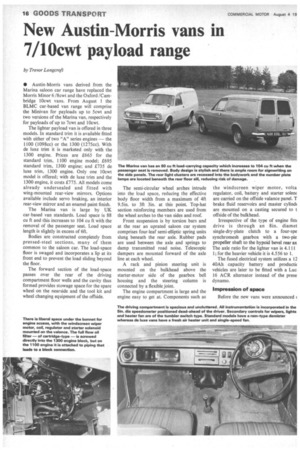New Austin-Morris vans in 7/10ewt payload range
Page 18

Page 19

If you've noticed an error in this article please click here to report it so we can fix it.
by Trevor Longcroft • Austin-Morris vans derived from the Marina saloon car range have replaced the Morris Minor 6 /8cwt and the Oxford /Cambridge 10ewt vans. From August 1 the BLMC car-based van range will comprise the Minivan for payloads up to 5cwt and two versions of the Marina van, respectively for payloads of up to 7cwt and lOcwt.
The lighter payload van is offered in three models. In standard trim it is available fitted with either of two "A" series engines — the 1100 (1098cc) or the 1300 (1275cc). With de luxe trim it is marketed only with the 1300 engine. Prices are £665 for the standard trim, 1100 engine model; £695 standard trim, 1300 engine; and £735 de luxe trim, 1300 engine. Only one lOcwt model is offered; with de luxe trim and the 1300 engine, it costs £775. All models come already undersealed and fitted with wing-mounted rear-view mirrors. Options available include servo braking, an interior rear-view mirror and an enamel paint finish.
The Marina van is large by UK car-based van standards. Load space is 88 Cu ft and this increases to 104 Cu ft with the removal of the passenger seat. Load space length is slightly in excess of 6ft.
Bodies are constructed completely from pressed-steel sections, many of them common to the saloon car. The load-space floor is swaged and incorporates a lip at its front end to prevent the load sliding beyond the floor.
The forward section of the load-space passes over the rear of the driving compartment floor wells and the cavity thus formed provides stowage space for the spare wheel on the nearside and the tool kit and wheel changing equipment of the offside. The semi-circular wheel arches intrude into the load space, reducing the effective body floor width from a maximum of 4ft 9.5in. to 3ft 3M. at this point. Top-hat section reinforcing members are used from the wheel arches to the van sides and roof.
Front suspension is by torsion bars and at the rear an uprated saloon car system comprises four-leaf semi-elliptic spring units slung beneath the rear axle. Rubber pads are used between the axle and springs to damp transmitted road noise. Telescopic dampers are mounted forward of the axle line at each wheel.
A rack and pinion steering unit is mounted on the bulkhead above the starter-motor side of the gearbox bell housing and the steering column is connected by a flexible joint.
The engine compartment is large and the engine easy to get at. Components such as the windscreen wiper motor, volta regulator, coil, battery and starter solem are carried on the offside valance panel. T brake fluid reservoirs and master cylinth are mounted on a casting secured to t offside of the bulkhead.
Irrespective of the type of engine fittc drive is through an •8in. diamet single-dry-plate clutch to a four-spe synchromesh gearbox with a two-pie propeller shaft to the hypoid bevel rear ax The axle ratio for the lighter van is 4.111 1; for the heavier vehicle it is 4.556 to 1.
The fused electrical system utilizes a 12 40Ah capacity battery and productic vehicles are later to be fitted with a Luc 16 ACR alternator instead of the prese dynamo.
Impression of space Before the new vans were announced .ugust 1 I had the opportunity to drive, for loft periods, both the 7cwt and the lOcwt iodels.
Each was loaded to approximately half s maximum capacity. The 7cwt version as fitted with the 1100 engine and had the ptional servo-assisted brakes. The lOcwt lode' was fitted with the 1300 engine.
First impression on sitting in these ehicles is that of space. The driving ompartment has ample leg room and there ; liberal adjustment for the seats. The gear ever projects up diagonally rearward from he floor and first and third gears are easily elected without leaning forward.
Steering wheel and pedals are directly in Me with the driver and steering was light vithout being vague. Pedal pressure for the iydraulically actuated clutch and brakes vas also light I would have preferred wider ipacing between accelerator and brake )edals.
Both models produced nippy acceleraion, good road going performance over the nixed roads encountered and cruised omfortably at a motorway 70 mph with
hrottle travel to spare. On hills the lower 3hp output of the smaller engined vehicle was noticeable against the performance of .he 1300 but it was by no means nadequate.
With servo assistance, the 7cwt stopped quicker than its lOcwt counterpart, showed particularly good braking response and came to rest from high speeds safely and surely. With the larger model more pedal pressure and anticipation of traffic conditions was needed.
In the limited time available for driving these vans it was not possible to obtain fuel consumption and other performance data, but CM will presently be carrying out full road tests of both vehicles.








































































































